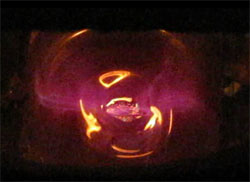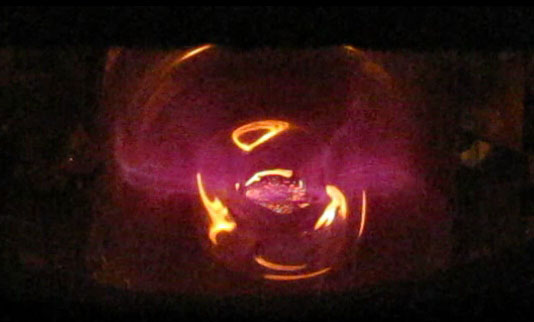Liquid Metal Stirs Itself
A magnetic field and heat can spin liquid metal into a whirlpool. In the 5 March Physical Review Letters researchers report the first direct observation and measurement of this effect, which they produced by hitting a tray of molten lithium with an electron beam in the presence of a magnetic field. Controlling the flow this way could be useful in future nuclear fusion reactors and in metallurgy.
In the most common fusion reactor designs, the inner wall is protected from the hot plasma by a material such as tungsten. But solid-coated walls can crack from the heat and can react with plasma particles, creating products that cool the plasma. Liquid metals could provide better protection, according to some researchers. The metal could stream down the wall like a waterfall and be pumped back to the top. Or it could flow through a mesh or porous material via capillary forces.
A flow controlled by temperature and magnetic fields, called a thermoelectric magnetohydrodynamic (TEMHD) flow, was first proposed for fusion reactors in 1979 [1] but the technology wasn’t yet ready. The idea was that creating a temperature difference would generate an electric current (thermoelectric effect) in a liquid metal. An external magnetic field would then produce a force on the entire fluid, just as a current-carrying wire feels a sideways force in a perpendicular magnetic field. Over the next two decades, there were some small and indirect indications of the effect, but no one had directly observed the induced motion in a controlled experiment.
In a 2005 experiment at Princeton University, researchers noticed that liquid lithium flowed when heated with an electron beam [2]. They thought the motion was triggered by heat-induced differences in surface tension–the so-called Marangoni effect, which also causes a thin film of water on a surface to flow away from a drop of alcohol.
To study this odd behavior, Mike Jaworski, David Ruzic, and their colleagues at the University of Illinois in Urbana applied a magnetic field to a 10-centimeter-square stainless steel tray filled to a depth of about a centimeter with molten lithium. They blasted the lithium with a ribbon-like beam of electrons, which focused heat along a line on the surface.
To their surprise, the team saw swirling liquid caused by a TEMHD mechanism, not the Marangoni effect. The heat generated an electric current along the lithium-stainless-steel interface at the bottom, with electrons in the tray moving away from the hot center and then completing the circuit by moving toward the hotest points inside the lithium. This thermoelectric effect, which relies on the metal-metal interface, is the principle behind a thermocouple, a type of thermometer that produces a voltage dependent on the temperature of a junction between two different metals. The magnetic force on this current caused rotation. By tracking impurities on the surface with a camera, the team measured rotation speeds of up to 30 centimeters per second.
The researchers ran several tests to confirm the TEMHD explanation. For example, the direction of the magentic field determined the direction of fluid rotation, and an electrically insulating layer below the lithium prevented the flow. Measured velocities also agreed with basic TEMHD theory.
This effect could be used to stir metal alloys more efficiently in industrial settings, Jaworski says. In fusion reactors, engineers could exploit the magnetic field and temperature gradients already present to control the flow of liquid metals. According to Mark Nornberg of the University of Wisconsin, Madison, self-stirring liquid lithium could also lead to improved reactor components, called divertors, that remove heat and impurities from the plasma. More details will need to be explored, but this work was a clean, proof-of-principle experiment, Nornberg says. “It’s a promising result for use of liquid metals in fusion experiments.”
–Marcus Woo
Marcus Woo is a freelance science writer in the San Francisco Bay Area.
References
- J. A. Shercliff, “Thermoelectric Magnetohydrodynamics,” J. Fluid Mech. 91, 231 (1979)
- R. Kaita, R. Majeski, T. Gray, H. Kugel, D. Mansfield, J. Spaleta, J. Timberlake, L. Zakharov, R. Doerner, T. Lynch, R. Maingi, and V. Soukhanovskii, “Low Recycling and High Power Density Handling Physics in the Current Drive Experiment-Upgrade with Lithium Plasma-Facing Components,” Phys. Plasmas 14, 056111 (2007)





